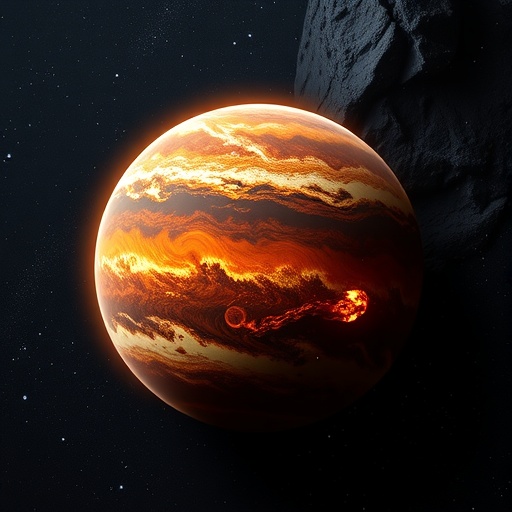The discovery of exoplanets over the past decades has unveiled a multitude of planetary types unlike anything found in our Solar System. Among these, the most prevalent class appears to be planets with rocky interiors overlain by thick, hydrogen-dominated atmospheres. These so-called “sub-Neptunes” or “mini-Neptunes” challenge our understanding of planet formation and composition, presenting a unique laboratory for studying planetary processes under extreme conditions. One of the most fascinating prospects is the interplay between the abundant atmospheric hydrogen and the deep silicate magma oceans thought to exist on these worlds. New experimental research now sheds light on this interaction, revealing that it may lead to the profound generation of water during early planetary evolution.
Unlike Earth, which formed with relatively thin hydrogen-poor atmospheres, these exotic planets possess envelopes rich in molecular hydrogen (H₂) that press upon molten rocky mantles under colossal pressures and temperatures. Theoretical models have long postulated that such an environment fosters chemical reactions between hydrogen gas and the underlying silicate magma, producing water that could profoundly alter the planet’s internal chemistry and atmospheric characteristics. However, these models have suffered from a dearth of direct experimental evidence, largely due to the immense technological challenges of recreating such extreme conditions in a laboratory setting.
Addressing this critical gap, an international team of researchers led by Miozzi, Shahar, and Young has conducted cutting-edge experiments using laser-heated diamond anvil cells to replicate the intense pressures ranging from 16 to 60 gigapascals (GPa) and temperatures exceeding 4000 Kelvin typical of magma ocean conditions in sub-Neptune interiors. These experiments are among the few to reach such extreme thermodynamic regimes while simultaneously probing the chemical interactions between molecular hydrogen and silicate melts, which are highly representative of planetary interiors.
The experimental results paint a remarkable picture: hydrogen, far from being chemically inert under these extreme conditions, dissolves copiously into silicate melts, with the degree of dissolution strongly influenced by temperature rather than pressure. As temperature rises, the solubility of hydrogen in the molten silicate increases significantly, indicating that hotter planetary interiors could promote more intense chemical exchange between atmosphere and magma than previously thought. This temperature-dependent solubility overturns prior assumptions that pressure would be the dominant factor controlling hydrogen incorporation.
In tandem with hydrogen dissolution, the experiments reveal a thermochemical transformation of iron-bearing components within the melt. Specifically, iron oxide (FeO), a common constituent of silicate minerals, undergoes reduction in the presence of molecular hydrogen. This reduction yields substantial quantities of water through the formation of hydroxyl groups in the silicate matrix, accompanied by the segregation of iron-rich metallic blebs. This process effectively converts atmospheric hydrogen and iron oxides into water and metallic iron, a reaction that was previously hypothesized but never empirically demonstrated at such extreme planetary conditions.
The implications of these findings ripple across several domains of planetary science. Foremost, they suggest that the typical accretion and differentiation processes during planet formation naturally generate significant amounts of water deep within planetary interiors, even in environments initially rich in hydrogen gas but poor in free oxygen. This in situ water production challenges the traditional view of water delivery solely via volatile-rich planetesimals or external cometary bombardment, positioning hydrogen-magma reactions as a central mechanism in early planetary water budgets.
Moreover, the generation of water in the deep magma ocean may influence the viscosity, melting behavior, and convective dynamics of planetary mantles. Water acts as a potent flux in silicate melts, lowering melting temperatures and facilitating differentiation, potentially shaping the evolution of magnetic fields, tectonics, and atmosphere-interior exchanges in sub-Neptune planets. The formation of iron-enriched metallic droplets could also contribute to the development of layered interiors or core formation pathways distinct from those on Earth.
From an atmospheric perspective, the findings imply that substantial water vapor could outgas from the magma ocean into the overlying hydrogen atmosphere, altering its chemical composition and spectral signatures. This could impact the detectability and characterization of exoplanet atmospheres through telescopes and space missions, providing new markers for the presence of internal magmatic activity and water generation.
Crucially, this experimental breakthrough bridges a fundamental knowledge gap between geochemistry, planetary physics, and exoplanetary atmospheric science. For the first time, robust laboratory measurements underpin hypotheses on hydrogen-silicate melt interactions, allowing modelers to refine simulations of planet formation, interior evolution, and volatile cycling on worlds vastly different from Earth. The work also opens paths for future experiments at even more extreme conditions or with varied starting compositions to explore the generality of these reactions.
The methodology employed—laser heating within a diamond anvil cell—represents the forefront of high-pressure experimental technology. By focusing an intense laser beam onto a tiny sample chamber compressed between two diamond anvils, temperatures above 4000 K are achieved while maintaining static pressures up to 60 GPa. This capability is essential to mimic the conditions deep inside planets many times more massive than Earth, where the magma ocean and atmosphere interact. Precise in situ spectroscopic probes elucidate the chemistry and phase changes occurring during experimentation.
In sum, the experimental results from Miozzi and colleagues signify a paradigm shift in our understanding of how water, a key ingredient for habitability and planetary evolution, can arise internally from primordial hydrogen atmospheres and magma oceans. Rather than requiring external sources, significant water inventories may be generated intrinsically through elemental reduction mechanisms at extreme conditions. This fundamentally alters conceptions of planetary volatile reservoirs and suggests a ubiquitous process that could operate throughout the Galaxy on countless rocky worlds with thick hydrogen envelopes.
As exploration of exoplanetary systems advances, integrating such high-pressure geochemical insights becomes indispensable for interpreting observational data and assessing the potential for habitable environments beyond Earth. This research stands as a milestone that unifies experimental petrology with exoplanet science, shedding light on the nature of worlds that, until recently, existed only in models and theoretical imaginations.
The future of planetary science lies in these interdisciplinary endeavors, where physics, chemistry, and astronomy converge to unravel the complex histories of distant planets. The newly revealed extreme generation of water during planet formation reinforces that the Universe’s capacity to produce diverse planetary outcomes is even more remarkable than imagined. With these findings, we take a crucial step closer to comprehending the diversity and complexity of planets orbiting other stars and the many ways in which the basic ingredients for life may assemble across cosmic time.
Subject of Research:
High-pressure experimental investigation of hydrogen-silicate melt interaction and water generation during planet formation.
Article Title:
Experiments reveal extreme water generation during planet formation.
Article References:
Miozzi, F., Shahar, A., Young, E.D. et al. Experiments reveal extreme water generation during planet formation. Nature (2025). https://doi.org/10.1038/s41586-025-09816-z
Image Credits: AI Generated
Tags: atmospheric chemistry of exoplanetschallenges in planetary researchchemical reactions in planetary interiorsexoplanet atmospheric compositionexperimental research in planetary scienceextreme planetary conditionshydrogen-rich exoplanetsimplications for habitability of exoplanetsplanet formation processessilicate magma oceanssub-Neptunes and mini-Neptuneswater production in planetary evolution





